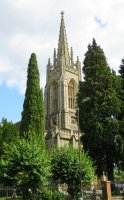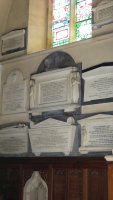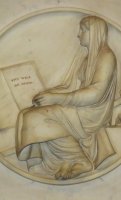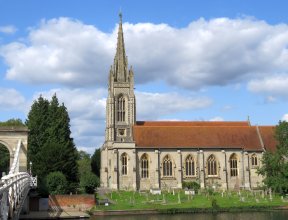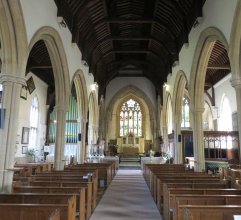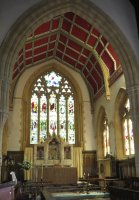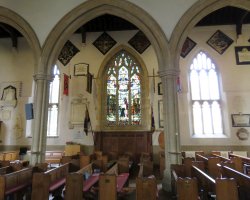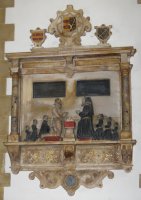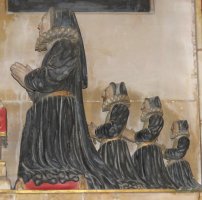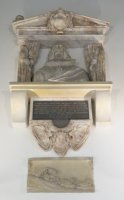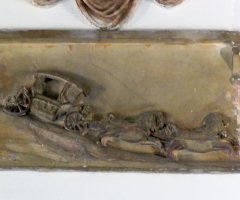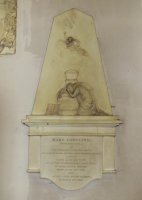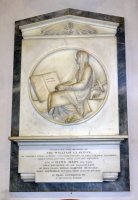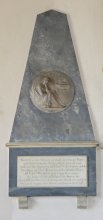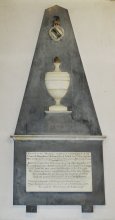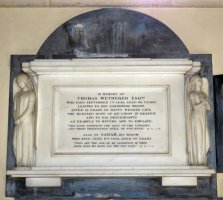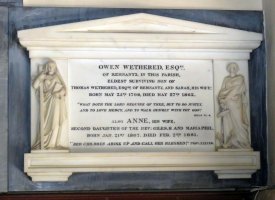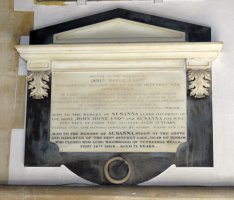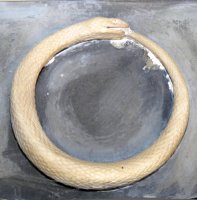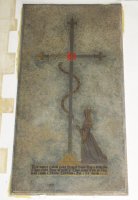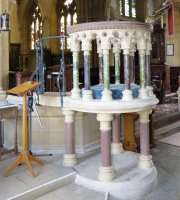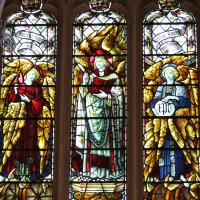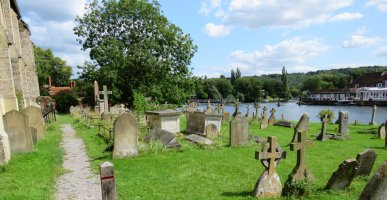All Saints Church, Marlow, Bucks - Monuments in 10 minutes
A 10-minute look at the monuments in All Saints Marlow, Buckinghamshire. It is a large 1830s church with over 40 monuments, some from the previous church on the site. You can see a range of monumental panel types, and work by a selection of sculptors. Click any picture to enlarge, or hover for caption.
All Saints Church, Marlow.
This page is for visitors who have only a brief time to see the Church and its monuments. When you have more time for a longer visit, see this much fuller description of all the monuments.
The Church replaced an ancient largely Norman structure, and dates from 1835. It is of pale Staffordshire brick and Bath stone, red tiled roofs, and a tower with chequerboard flint patterning at the upper level, and a stone steeple. Charles Frederick Inwood was the architect, John Oldrid Scott, son of the famous George Gilbert Scott, did the spire and upper tower and some other work towards the end of the century.
Chancel, and several of the monuments.
Inside, the walls are studded with the monuments we have come to see - one great 16th Century kneeler monument, one 17th Century panel, and around 40 later ones, mostly white-on-black panels, and plain white ones, and including several figure pieces.
Catheryne Willoughby, d.1597.
We start with the kneeler monument, to Catheryne Willoughby, d.1597, with a touching eulogy by her husband, William Willoughby, writing of 'so rare a wyef, P'formde [performed] these duties of love never dyinge, behold this toombe, with a regarding eye, and reade my losse her worth which here doth lye'. Husband and wife are kneeling on tasselled cushions and praying. He wears armour, she black robes and a headpiece, and both have ruffs. Behind them are ranked their offspring, three small male figures behind their father, three girls behind their mother. A colourful monument in alabaster, with paint, gilt and cabuchons at the base.
Sir Myles Hobart, Knight, d.1632.
Next in age is the portrait bust of Sir Myles Hobart, Knight, d.1632 [also spelt Sir Miles Hobart], with sweeping down hair to the sides and a moustache, a large ruff, and cloak. Small alabaster figures hold back curtain to the sides, and above is a heavy pediment, with a now blank cartouche of arms. The oversized shelf beneath is modern, and then the inscription in gilt on black as is normal for the period, and a winged cherubic head. Immediately underneath is a small plaque carved with a carriage and four horses, the scene when Sir Myles plunged down Holborn Hill to his death.
Carved monuments to the Claytons (hover for captions).
The Church contains a number of panels to the Clayton family, and here are two with carvings, both by important sculptors of funerary monuments. Above left, we have Mary Caroline Clayton, d.1812, daughter of one baronet, and grand-daughter of another on her mother's side. It has a tall obelisk, with a carving of a Classically draped girl slumped in grief against a monument to the deceased, one arm thrown forward, the other hand against her brow, while above, a small winged figure represents the departing soul. The sculptor was John Bacon the Younger, maker of many good monuments. (For lots more classical girls, see this page.) And above right we have Sir William Clayton, Baronet, d.1834, with a carving of a seated girl, hands together on her lap, with a cross and a book open to the words 'Thy will be done'. This is by the very eminent sculptor Sir Richard Westmacott RA, of great renown and prodigious output of monuments.
Obelisk monuments to the Cleoburey family.
Next, we have two further tall obelisk monuments, to Elizabeth [Keen] Cleoburey, d.1777, and to two Reverend John Cleobureys - the one who died in 1801 was her husband. Her monument has a roundel with a carving of a seated girl next leaning on her elbow, staring down contemplatively, supposed to represent Religion; in low relief in the background is a pillar bearing a broad urn.
More carving by the Westmacott sculptors: Wethered monuments.
Next, we have a long sequence of monuments to the Wethered family, mostly white-on-black panels, and plain white ones, characteristic of their time. They include two with figure sculpture by members of the Westmacott family of sculptors, who we met above with Sir Richard Westmacott RA. Above left we have Thomas Wethered, d.1849, and his wife Sarah Wethered, d.1856, by a son of Sir Richard, Richard Westmacott RA, junior, with a charming pair of angels. And above right is the panel to Owen Wethered, d.1862, son of Thomas Wethered, and his wife Anne [Peel] Wethered, d.1881, with two standing females, representing Faith (with the cross and Bible) and Constancy (with the anchor). The sculptor was James Sherwood Westmacott, a nephew of Sir Richard - he was a portrait sculptor, and made statues for Burlington House, and it is really quite unusual to find a monument by him. If you want more on the Westmacott dynasty, see this page.
John Hone, with carved snake.
This white-on-black panel, to John Hone, d.1824, and added later, his daughter Susanna Hone, d.1844, and his wife Susanna Hone, d.1869, includes at the base, a small snake biting its tail, which is a nicely pagan Nordic symbol of rebirth.
Slab with brass to Catherine Vernon.
One more panel to spot is that to Catherine Gladell Vernon, d.1844 (I think), an unusual modern brass on a stone slab with a Cross fleury (i.e. with little fleurs-de-lys at the ends of the branches and top - there are various cross designs described on the page about churchyard monuments with crosses), and a ribbon with Biblical quotation wound round it; at the base is the kneeling female figure representing the deceased.
Victorian pulpit and stained glass in the Church.
The Church has some good Victorian furnishings, especially the highly unusual pulpit with an open balustrade of colourful stone pillars. And the stained glass includes both very good Victorian and modern lights.
Outside, the churchyard is next to the River Thames, with fine views, and a nice place to sit by the water, most peaceful. There is a fair selection of upright tombstones, including a good collection of variations on crosses (see the page about such things), mostly 19th and early 20th Century but with a few 18th century pieces, several tombs to members of the Wethered family we met in the Church, and a big pink granite obelisk to the Carson family, mid Victorian, with a kneeling figure of a praying angel.
Remember, if you have time for a longer visit and want more about the monuments, see this longer page.
And the Church's own website is at https://4u-team.org/churches/all-saints-marlow/.
Also in Marlow: The Frohman memorial statue.


